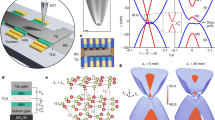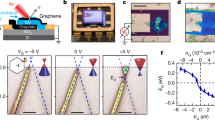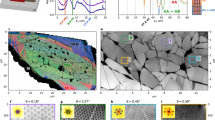Abstract
Graphene has remarkable electronic properties, such as ballistic transport and quantum Hall effects1,2,3, and has also been used as a support for samples in high-resolution transmission electron microscopy4,5 and as a transparent electrode in photovoltaic devices6. There is now a demand for techniques that can manipulate the structural and physical properties of graphene, in conjunction with the facility to monitor the changes in situ with atomic precision. Here, we show that irradiation with an 80 kV electron beam can selectively remove monolayers in few-layer graphene sheets by means of electron-beam-induced sputtering. Aberration-corrected, low-voltage, high-resolution transmission electron microscopy with sub-ångström resolution is used to examine the structural reconstruction occurring at the single atomic level. We find preferential termination for graphene layers along the zigzag orientation for large hole sizes. The temporal resolution can also be reduced to 80 ms, enabling real-time observation of the reconstruction of carbon atoms during the sputtering process. We also report electron-beam-induced rapid displacement of monolayers, fast elastic distortions and flexible bending at the edges of graphene sheets. These results reveal how energy transfer from the electron beam to few-layer graphene sheets leads to unique structural transformations.
This is a preview of subscription content, access via your institution
Access options
Subscribe to this journal
Receive 12 print issues and online access
$259.00 per year
only $21.58 per issue
Buy this article
- Purchase on Springer Link
- Instant access to full article PDF
Prices may be subject to local taxes which are calculated during checkout




Similar content being viewed by others
References
Du, X., Skachko, I., Barker, A. & Andrei, E. Y. Approaching ballistic transport in suspended graphene. Nature Nanotech. 3, 491–495 (2008).
Novoselov, K. S. et al. Electric field effect in atomically thin carbon films. Science 306, 666–669 (2004).
Novoselov, K. S. et al. Two-dimensional gas of massless Dirac fermions in graphene. Nature 438, 197–200 (2005).
Meyer, J. C., Girit, C. O., Crommie, M. F. & Zettl, A. Imaging and dynamics of light atoms and molecules on graphene. Nature 454, 319–322 (2008).
Meyer, J. C. et al. Direct imaging of lattice atoms and topological defects in graphene membranes. Nano Lett. 8, 3582–3586 (2008).
Wang, X., Zhi, L. & Mullen, K. Transparent, conductive graphene electrodes for dye-sensitized solar cells. Nano Lett. 8, 323–327 (2008).
Terrones, M., Terrones, H., Banhart, F., Charlier, J.-C. & Ajayan, P. M. Coalescence of single-walled carbon nanotubes. Science 288, 1226–1229 (2000).
Banhart, F. & Ajayan, P. M. Carbon onions as nanoscopic pressure cells for diamond formation. Nature 382, 433–435 (1996).
Hernandez, E. et al. Fullerene coalescence in nanopeapods: a path to novel tubular carbon. Nano Lett. 3, 1037–1042 (2003).
Warner, J. H. et al. Rotating fullerene chains in carbon nanopeapods. Nano Lett. 8, 2328–2335 (2008).
Li, J. & Banhart, F. The engineering of hot carbon nanotubes with a focused electron beam. Nano Lett. 4, 1143–1146 (2004).
Rodriguez-Manzo, J. A. et al. In situ nucleation of carbon nanotubes by the ejection of carbon atoms into metal particles. Nature Nanotech. 2, 307–311 (2007).
Hashimoto, A., Suenaga, K., Gloter, A., Urita, K. & Iijima, S. Direct evidence for atomic defects in graphene layers. Nature 430, 870–873 (2004).
Suenaga, K. et al. Imaging active topological defects in carbon nanotubes. Nature Nanotech. 2, 358–360 (2007).
Meyer, J. C. et al. The structure of suspended graphene sheets. Nature 446, 60–63 (2007).
Egerton, R. F., Li, P. & Malac, M. Radiation damage in the TEM and SEM. Micron 35, 399–409 (2004).
Terrones, M. et al. Molecular junctions by joining single-walled carbon nanotubes. Phys. Rev. Lett. 89, 0755051 (2002).
Park, H. S., Baskin, J. S., Kwon, O.-H. & Zewail, A. H. Atomic-scale imaging in real and energy space developed in ultrafast electron microscopy. Nano Lett. 7, 2545–2551 (2007).
Jia, X. et al. Controlled formation of sharp zigzag and armchair edges in graphitic nanoribbons. Science 323, 1701–1705 (2009).
Dovesi, R. et al. CRYSTAL06 User's Manual (University of Torino, 2006).
Girit, Ç. Ö. et al. Graphene at the edge: stability and dynamics. Science 323, 1705–1708 (2009).
Lee, C., Wei, X., Kysar, J. W. & Hone, J. Measurement of the elastic properties and intrinsic strength of monolayer graphene. Science 321, 385–388 (2008).
Acknowledgements
J.H.W. thanks the Violette and Samuel Glasstone Fund and Brasenose College, Oxford, for support. This work was supported in part by the Engineering and Physical Sciences Research Council (EPSRC) through the Quantum Information Processing Interdisciplinary Research Collaboration (GR/S82176/01). G.A.D.B. thanks the EPSRC for a Professorial Research Fellowship (GR/S15808/01). We thank J. H. Jefferson for discussions.
Author information
Authors and Affiliations
Contributions
J.H.W. designed and conducted the experiments, analysed the results and wrote the paper. M.R., T.G. and B.B. assisted with the HRTEM measurements. L.G., B.M. and N.M.H. performed the density functional theory (DFT). G.A.D.B. assisted in the analysis of the results.
Corresponding author
Supplementary information
Supplementary information
Supplementary information (PDF 3297 kb)
Supplementary information
Supplementary movie 1 (MOV 9186 kb)
Supplementary information
Supplementary movie 2 (MOV 10350 kb)
Supplementary information
Supplementary movie 3 (MOV 10467 kb)
Supplementary information
Supplementary movie 4 (MOV 2313 kb)
Rights and permissions
About this article
Cite this article
Warner, J., Rümmeli, M., Ge, L. et al. Structural transformations in graphene studied with high spatial and temporal resolution. Nature Nanotech 4, 500–504 (2009). https://doi.org/10.1038/nnano.2009.194
Received:
Accepted:
Published:
Issue Date:
DOI: https://doi.org/10.1038/nnano.2009.194
This article is cited by
-
Disorders in graphene: types, effects and control techniques—a review
Carbon Letters (2022)
-
Oxygen-assisted direct growth of large-domain and high-quality graphene on glass targeting advanced optical filter applications
Nano Research (2021)
-
Chemically induced transformation of chemical vapour deposition grown bilayer graphene into fluorinated single-layer diamond
Nature Nanotechnology (2020)
-
Single Cr atom catalytic growth of graphene
Nano Research (2018)
-
Chemical modification of graphene oxide through poly(ethylene oxide)-conjugations
Macromolecular Research (2017)



